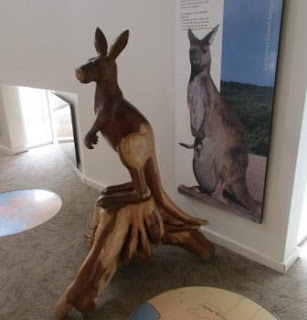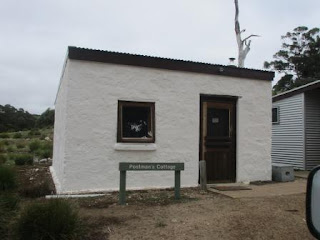23
degrees – heavy mist still over us. Packed up and continued along the highway. Crossed
the South West River which flows out to Hanson Bay. Should be some koalas in
the trees around here as there are two Koala Walk places along here.
Past
a huge plantation of tall eucalypt trees.
Reached
Flinders Chase National Park entrance then turned right and headed north to
Gary & Margaret’s friends farm. Steven and Kerryn were happy to have us park
the van for a few days near their accommodation area. The accommodation
manager, Verity, greeted us and we set up.
It
is a great spot with a bathroom growing a vine that I think is Monstera
Deliciosa (will have to ask Dad – I googled it instead – see below).
They
were originally raising sheep and had the accommodation area then slowly
expanded and then went into ‘seed’ potatoes. The sheep get the left over
damaged potatoes to snack on.
A
flock of Cape Barren geese flew over.
Steve
arrived and we chatted to him about the potato industry. A good seed potato is
about 50mm. They are sorted into sizes by his staff (mainly international
backpackers doing their 100 days rural work to be able to apply for a longer
visa) using these machines. He invited us to join him for a tour and watch how it all works on
Monday.
Made
some lunch and sat around the fire pit outside the camp kitchen.
Steve
said to call in on Kerryn at their home near the turn off to Hanson Bay.
Introduced ourselves and chatted for a while then headed down the road to
Hanson Bay. The South West River doesn’t quite make it to the sea either.
A
beautiful spot, even on a bleak day.
Rugged
coastline around to Cape Bouguer.
Bright
seaweed.
Spotted
a crab down on a rock by the water.
Wandered
along the cliff top enjoying the view.
Interesting
rock formations.
Watch
where you step as there are holes everywhere.
Continued
along till we spotted Southern Ocean Lodge.
Further
around is Cape Younghusband – will have to google that name as it is also the
Peninsula near Goolwa.
Leanne
& Rick headed back to the van but we drove into the National Park to pick
up a brochure on the walks etc. Steve found a couple of friends up in the trees
in the carpark. Lucky my zoom works well. Don’t have to go to the Koala Walks
now.
Lots
of information to read inside. The koalas are eating themselves out of a home.
Great
carving of a Kangaroo Island kangaroo which is one of three subspecies of the
Western Grey kangaroo. It is smaller and more solidly built; has shorter tail,
ears and limbs; has a broader muzzle and jaw; has longer, thicker and darker
brown fur than the mainland relatives.
Lovely
mural depicting all the plants and wildlife on the island.
Eucalyptus
farming still happens today.
Got
my walk guide and checked on the weather – still going to be overcast and
getting a bit colder. She said the high humidity was unusual and the low cloud
cover. The fog is not unusual to come in from the Southern Ocean.
Found
another couple of koalas on the way back to the truck.
Down
the road are two accommodation places – one was the Postman’s Cottage, a
one-roomed stone hut built for the mailman who would call and stay overnight
once a fortnight.
The
other is May’s Homestead which is heritage-listed. The four-roomed stone
cottage was built in the early 1890s. During its history, the occupants were
the nearest source of help whenever a ship was wrecked along the rugged
coastline.
Back
to the van for a cuppa. The sun has come out – worthy of a photo!!
Steve
pulled Leanne’s fridge burner apart while we had the fridges on 240volt and got
it cleaned up while I continued on my quest to catch up on my blog.
Had
our drinks under the awning when we should had been sitting in the sunshine!!
We were going to get a fire going in the firepit but left it too late and it
was getting colder so went into our vans for dinner. Took the Sequence over to
Leanne’s van and played a few games. I could see stars when I went to the
shower block later. Steve got hooked on a movie so we didn’t get to bed till
11.30pm and it was 21.4 degrees in the van then but a lot cooler outside.
Monstera deliciosa, commonly called the fruit salad plant,
is a native of Mexico and Central America. It is a climber that under ideal
conditions can reach to 9 m, with leaves up to 1 m wide. Its aerial roots cling
to a support, or form a dense mat on the ground when unsupported. LOCATION M.
deliciosa can withstand cold conditions provided it is sheltered from frost and
cold winds and it tolerates a wide range of soil types. However, it prefers
moist, warm situations and grows more rapidly in well drained soil rich in
organic matter. It is especially suited for use as an ornamental on fences and
tree stumps; its strong growth makes it unsuitable for planting alongside
buildings. HARVESTING The elongated fruit is ready to harvest when the caps of
the fruitlets at the base start to spread and show creamy colour between them,
usually, about 12 months after flowering. When mature, the fruit can be brokcn
off, leaving the flower stem. After harvest, place the fruit in a paper bag in
a warm position and in a day or so the green caps will fall from the ripened
section at the base of the fruit and expose the edible portion beneath. Do not
eat from the section where the caps have not been shed, for severe irritation
of the throat can be caused by oxalate and also by the small black scales
between the edible segments within the fruit. Leave the unripe section in the
paper bag until the next portion is ready to eat. Alternatively, the whole
fruit can be ripened for eating at one time by standing the base in water and
keeping it in the dark for a few days.






























































No comments:
Post a Comment